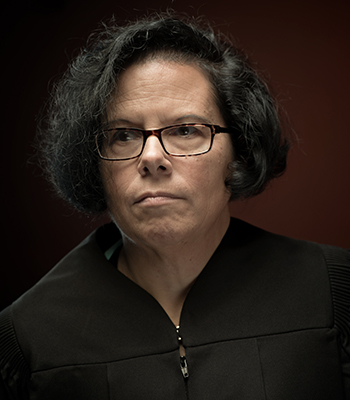“Sister” or “Judge”: This Latter-day Saint and Mohawk Tribe Member Answers to Both
Contributed By Jason Swensen, Church News associate editor

Carrie Garrow, second from the left, is called Sister Garrow by the young women she works with in the Massena Branch. But she is referred to as the Honorable Judge Carrie Garrow when she is working in her position as chief appellate justice in the St. Regis Mohawk Tribal Court.
Article Highlights
- Sister Garrow serves as the branch and district Young Women president.
- She is a leader in the development of tribal justice systems.
- She uses her experiences to encourage other Native students.
Related Links
ST. REGIS MOHAWK RESERVATION, NEW YORK
When the young women from the Massena Branch need to chat with their adviser, Carrie Garrow, there’s no need to ask “to approach the bench.”
But if they ever find themselves in the St. Regis Mohawk Tribal Court, it’s always wise to follow courtroom protocol.
Young Women youth leader Sister Garrow also answers to the Honorable Judge Carrie Garrow, chief appellate justice, St. Regis Mohawk Tribal Court.

Lifelong Latter-day Saint Carrie Garrow serves as chief appellate judge of the St. Regis Mohawk Tribal Court—and as Young Women president in her northern New York branch. Photo courtesy of Judge Carrie Garrow.
Garrow’s two jobs might seem to function on opposite ends, but they’re both natural fits for this lifelong Latter-day Saint, Akwesasne Mohawk tribe member, and nationally renowned expert on tribal law and governance.
The affable Garrow doesn’t talk much about either her Church or judicial capacity—but her associates are quick to speak for her.
First, this comment from her local priesthood leader, Massena Branch president John Chapman:
“Carrie is our Young Women branch and district president, and the young women just love her. She is a great role model.”

Judge Carrie Garrow, second from the right, participates in a panel discussion during a recent symposium at BYU’s law school. Photo courtesy of BYU Law School.
And from Michalyn Steele, a BYU law professor and a Seneca tribe member:
“Judge Garrow is a leader in the development of tribal justice systems. … She understands and applies traditional indigenous principles, including restorative justice, in her scholarship and in her tribal court work.”
The daughter of two Church converts (Cecil and Barbara Garrow), Garrow grew up in northern New York on the Mohawk Indian reservation known by its indigenous name, Akwesasne (translated: Land Where the Partridge Drums).
Membership in her local branch was numerically scant, but Garrow said she never really noticed. She relishes her childhood Latter-day Saint experience. Her parents served as the branch’s president and Relief Society president. “Sometimes at the same time.” And the Church in rural Franklin County was a place where everyone knew everyone and looked out for each other.
“Growing up, we didn’t know any different,” she said. “My parents were amazing and would take me to all the youth activities in the Montreal area.”
The Garrows also taught their children to treasure education and public service. “Our family conversations were always, ‘Where are you going to college?’ not ‘If you are going to college.’”
She discovered an early fascination for the law. Even before beginning undergraduate studies at Dartmouth, she knew she would be her immediate family’s first legal eagle.
As a member of a storied tribe, Garrow also recognized demands for well-trained lawyers within the Mohawk community. “There’s definitely a need within our government to have our own tribal members fulfill and help build our tribe’s infrastructure. And there’s a need to help our people interact with outside governments.”
After graduating from Dartmouth, Garrow swapped coasts and began law studies at Stanford University. She battled occasional bouts of homesickness—“I’m kind of a homebody”—but enjoyed the rigor and study alongside several fellow Native American students.
“And for the first time in my life I was in a huge ward,” she said. “It was fun.”
With law degree in hand, she worked several years as a deputy district attorney in California’s Riverside County before heading back to the East Coast.
While pursuing a graduate degree in public policy from Harvard, she met a tribal court judge who encouraged her to consider serving on the bench. “It was something I had never really considered,” she said.
But the seed had been planted. After teaching for a few years at Syracuse University College of Law, she found herself back home wearing the judge’s robes. She was elected as her tribe’s chief appellate judge in 2016.
“I love my job,” she said. “It’s hard and I take it very seriously. But I love it; there’s something new every day.”
The tribal court works closely with the outside court systems while protecting the values of the Mohawk community, culture, and people. Common cases include land and property disputes, divorces, and other traditional civil law matters.
A tribal court of and by the people is essential to protecting a sovereign nation’s needs while offering legal resources to its people, she said.
She often finds herself in front of young people at church and in the local schools. “I try to share my experience and encourage other Native students.”
Being a Latter-day Saint, she added, has proven a professional benefit. “Having the gospel has helped me take different turns in my life and provided me with faith when things don’t turn out the way I had hoped they would.”

Judge Carrie Garrow, bottom row second from the left, participated earlier this year in a BYU law symposium on sovereign resilience. Photo courtesy of BYU Law School.
